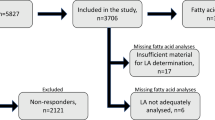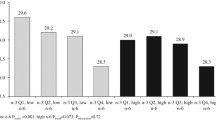Abstract
Fatty acids (FAs) are essential components of cell membranes and play an integral role in membrane fluidity. The lipophilic index [LI, defined as the sum of the products between FA levels and melting points (°C), divided by the total amount of FA: \({\text{LI}} = \frac{{\mathop \sum \nolimits_{k} [{\text{fatty acid}} \times {\text{melting point}}]}}{{\mathop \sum \nolimits_{k} {\text{fatty acid}} }}\)] is thought to reflect membrane and lipoprotein fluidity and may be associated with the risk of coronary heart disease (CHD). Therefore, we examined the associations of dietary and plasma phospholipid (PL) LI with CHD risk among postmenopausal women. We determined dietary LI for the cohort with completed baseline food frequency questionnaires and free of prevalent cardiovascular diseases in the Women’s Health Initiative (WHI) observational study (N = 85,563). We additionally determined plasma PL LI in a matched case-control study (N = 2428) nested within the WHI observational cohort study. Cox proportional hazard regression and multivariable conditional logistic regression were used to calculate HRs/ORs for CHD risk between quartiles of LI after adjusting for potential sources of confounding and selection bias. Higher dietary LI in the cohort study and plasma PL LI in the case-control study were significantly associated with increased risk of CHD: HR = 1.18 (95% CI 1.07–1.31, P for trend <0.01) and OR = 1.76 (95% CI 1.33–2.33, P for trend <0.01) comparing extreme quartiles and adjusting for potential confounders. These associations still persisted after adjusting for the polyunsaturated to saturated fat ratio. Our study indicated that higher LI based on either dietary or plasma measurements, representing higher FA lipophilicity, was associated with elevated risk of CHD among postmenopausal women.

Similar content being viewed by others
Abbreviations
- BMI:
-
Body mass index
- CHD:
-
Coronary heart disease
- CI:
-
Confidence interval
- CVD:
-
Cardiovascular disease
- FA:
-
Fatty acid
- HR:
-
Hazard ratio
- IQR:
-
Interquartile range
- LI:
-
Lipophilic index
- MET:
-
Metabolic equivalent of task
- MUFA:
-
Monounsaturated fatty acid
- OR:
-
Odds ratio
- PL:
-
Phospholipid
- PUFA:
-
Polyunsaturated fatty acid
- RR:
-
Risk ratio
- SD:
-
Standard deviation
- SFA:
-
Saturated fatty acid
- TFA:
-
Trans fatty acid
- WHI:
-
Women’s Health Initiative
References
Mozaffarian D et al (2015) Heart disease and stroke statistics—2015 update: a report from the American Heart Association. Circulation 131(4):e29–e322
The Antiretroviral Therapy Cohort Collaboration (2013) Influence of geographical origin and ethnicity on mortality in patients on antiretroviral therapy in Canada, Europe, and the United States. Clin Infect Dis 56(12):1800–1809 (Epub 2013 March 1)
Cooper RA (1977) Abnormalities of cell-membrane fluidity in the pathogenesis of disease. N Engl J Med 297(7):371–377
Hodson L, Skeaff CM, Fielding BA (2008) Fatty acid composition of adipose tissue and blood in humans and its use as a biomarker of dietary intake. Prog Lipid Res 47(5):348–380
Ding EL et al (2008) Lipophilic index of fatty acid fluidity in erythrocyte and plasma and risk of coronary heart disease. Circulation 118(S_1089):10
Wu H et al (2013) A novel fatty acid lipophilic index and risk of CHD in US men: the health professionals follow-up study. Br J Nutr 110(3):466–474
Toledo E et al (2013) A novel fatty acid profile index—the lipophilic index—and risk of myocardial infarction. Am J Epidemiol 178(3):392–400
The Women’s Health Initiative Study Group (1998) Design of the Women’s Health Initiative clinical trial and observational study. Control Clin Trials 19(1):61–109
Hays J et al (2003) The Women’s Health Initiative recruitment methods and results. Ann Epidemiol 13(9 Suppl):S18–S77
Curb JD et al (2003) Outcomes ascertainment and adjudication methods in the Women’s Health Initiative. Ann Epidemiol 13(9 Suppl):S122–S128
Matthan NR et al. (2014) Plasma phospholipid fatty acid biomarkers of dietary fat quality and endogenous metabolism predict coronary heart disease risk: a nested case-control study within the Women’s Health Initiative Observational Study. J Am Heart Assoc 3(4). doi:10.1161/JAHA.113.000764
Lichtenstein AH et al (2006) Novel soybean oils with different fatty acid profiles alter cardiovascular disease risk factors in moderately hyperlipidemic subjects. Am J Clin Nutr 84(3):497–504
Hu FB et al (1999) Dietary fat and coronary heart disease: a comparison of approaches for adjusting for total energy intake and modeling repeated dietary measurements. Am J Epidemiol 149(6):531–540
Bertoia ML et al (2013) Long-term alcohol and caffeine intake and risk of sudden cardiac death in women. Am J Clin Nutr 97(6):1356–1363
Resche-Rigon M, White IR (2016) Multiple imputation by chained equations for systematically and sporadically missing multilevel data. Stat Methods Med Res. doi:10.1177/0962280216666564
Office of National AIDS Policy. National HIV/AIDS Strategy for the United States: Update of 2014 Federal Actions to Achieve National Goals and Improve Outcomes Along the HIV Care Continuum. 2014
McTiernan A et al (2003) Recreational physical activity and the risk of breast cancer in postmenopausal women: the Women’s Health Initiative Cohort Study. JAMA 290(10):1331–1336
Hernán MA, Hernandez-Diaz S, Robins JM (2004) A structural approach to selection bias. Epidemiology 15(5):615–625
Howe CJ et al (2016) Selection bias due to loss to follow up in cohort studies. Epidemiology 27(1):91–97
Hernan MA et al (2002) Causal knowledge as a prerequisite for confounding evaluation: an application to birth defects epidemiology. Am J Epidemiol 155(2):176–184
Ding EL et al (2015) Dietary lipophilic load and dietary lipophilic index with risk of coronary heart disease in middle-aged women: beyond conventional fat classifications. Circulation 131(Suppl 1):A19
van Meer G, Voelker DR, Feigenson GW (2008) Membrane lipids: where they are and how they behave. Nat Rev Mol Cell Biol 9(2):112–124
Zicha J, Kunes J, Devynck MA (1999) Abnormalities of membrane function and lipid metabolism in hypertension: a review. Am J Hypertens 12(3):315–331
Singh U, Jialal I (2006) Oxidative stress and atherosclerosis. Pathophysiology 13(3):129–142
Dumas D et al (1999) Membrane fluidity and oxygen diffusion in cholesterol-enriched endothelial cells. Clin Hemorheol Microcirc 21(3–4):255–261
Gojova A, Barakat AI (2005) Vascular endothelial wound closure under shear stress: role of membrane fluidity and flow-sensitive ion channels. J Appl Physiol (1985) 98(6):2355–2362
Tsuda K (2015) Association of resistin with impaired membrane fluidity of red blood cells in hypertensive and normotensive men: an electron paramagnetic resonance study. Heart Vessels 31(10):1724–1730. doi:10.1007/s00380-015-0755-0
Sola R et al (1990) Effects of dietary fats on the fluidity of human high-density lipoprotein: influence of the overall composition and phospholipid fatty acids. Biochim Biophys Acta 1043(1):43–51
Soutar A (1978) Does dietary fat influence plasma lipoprotein structure? Nature 273(5657):11–12
Parks JS et al (2000) Phosphatidylcholine fluidity and structure affect lecithin:cholesterol acyltransferase activity. J Lipid Res 41(4):546–553
Berrougui H et al (2007) Age-related impairment of HDL-mediated cholesterol efflux. J Lipid Res 48(2):328–336
Harper CR, Jacobson TA (2001) The fats of life: the role of omega-3 fatty acids in the prevention of coronary heart disease. Arch Intern Med 161(18):2185–2192
Demaison L, Moreau D (2002) Dietary n-3 polyunsaturated fatty acids and coronary heart disease-related mortality: a possible mechanism of action. Cell Mol Life Sci 59(3):463–477
Mozaffarian D, Wu JH (2011) Omega-3 fatty acids and cardiovascular disease: effects on risk factors, molecular pathways, and clinical events. J Am Coll Cardiol 58(20):2047–2067
Clarke SD (2004) The multi-dimensional regulation of gene expression by fatty acids: polyunsaturated fats as nutrient sensors. Curr Opin Lipidol 15(1):13–18
Manco M, Calvani M, Mingrone G (2004) Effects of dietary fatty acids on insulin sensitivity and secretion. Diabetes Obes Metab 6(6):402–413
Emken EA et al (1979) Incorporation of deuterium-labeled cis- and trans-9-octadecenoic acids in humans: plasma, erythrocyte, and platelet phospholipids. Lipids 14(6):547–554
Mozaffarian D et al (2006) Trans fatty acids and cardiovascular disease. N Engl J Med 354(15):1601–1613
Sun Q et al (2007) A prospective study of trans fatty acids in erythrocytes and risk of coronary heart disease. Circulation 115(14):1858–1865
Acknowledgements
WHI investigators Program Office: (National Heart, Lung, and Blood Institute, Bethesda, Maryland) Elizabeth Nabel, Jacques Rossouw, Shari Ludlam, Joan McGowan, Leslie Ford, and Nancy Geller. Clinical Coordinating Center: (Fred Hutchinson Cancer Research Center, Seattle, WA). Ross Prentice, Garnet Anderson, Andrea LaCroix, Charles L. Kooperberg, Ruth E. Patterson, Anne McTiernan; (Medical Research Labs, Highland Heights, KY) Evan Stein; (University of California at San Francisco, San Francisco, CA) Steven Cummings. Clinical Centers: (Albert Einstein College of Medicine, Bronx, NY) Sylvia Wassertheil-Smoller; (Baylor College of Medicine, Houston, TX) Aleksandar Rajkovic; (Brigham and Women’s Hospital, Harvard Medical School, Boston, MA) JoAnn E. Manson; (Brown University, Providence, RI) Charles B. Eaton; (Emory University, Atlanta, GA) Lawrence Phillips; (Fred Hutchinson Cancer Research Center, Seattle, WA) Shirley Beresford; (George Washington University Medical Center, Washington, DC) Lisa Martin; (Los Angeles Biomedical Research Institute at Harbor-UCLA Medical Center, Torrance, CA) Rowan Chlebowski; (Kaiser Permanente Center for Health Research, Portland, OR) Yvonne Michael; (Kaiser Permanente Division of Research, Oakland, CA) Bette Caan; (Medical College of Wisconsin, Milwaukee, WI) Jane Morley Kotchen; (MedStar Research Institute/Howard University, Washington, DC) Barbara V. Howard; (Northwestern University, Chicago/Evanston, IL) Linda Van Horn; (Rush Medical Center, Chicago, IL) Henry Black; (Stanford Prevention Research Center, Stanford, CA) Marcia L. Stefanick; (State University of New York at Stony Brook, Stony Brook, NY) Dorothy Lane; (The Ohio State University, Columbus, OH) Rebecca Jackson; (University of Alabama at Birmingham, Birmingham, AL) Cora E. Lewis; (University of Arizona, Tucson/Phoenix, AZ) Cynthia A Thomson; (University at Buffalo, Buffalo, NY) Jean Wactawski-Wende; (University of California at Davis, Sacramento, CA) John Robbins; (University of California at Irvine, CA) F. Allan Hubbell; (University of California at Los Angeles, Los Angeles, CA) Lauren Nathan; (University of California at San Diego, LaJolla/Chula Vista, CA) Robert D. Langer; (University of Cincinnati, Cincinnati, OH) Margery Gass; (University of Florida, Gainesville/Jacksonville, FL) Marian Limacher; (University of Hawaii, Honolulu, HI) J. David Curb; (University of Iowa, Iowa City/Davenport, IA) Robert Wallace; (University of Massachusetts/Fallon Clinic, Worcester, MA) Judith Ockene; (University of Medicine and Dentistry of New Jersey, Newark, NJ) Norman Lasser; (University of Miami, Miami, FL) Mary Jo O’Sullivan; (University of Minnesota, Minneapolis, MN) Karen Margolis; (University of Nevada, Reno, NV) Robert Brunner; (University of North Carolina, Chapel Hill, NC) Gerardo Heiss; (University of Pittsburgh, Pittsburgh, PA) Lewis Kuller; (University of Tennessee Health Science Center, Memphis, TN) Karen C. Johnson; (University of Texas Health Science Center, San Antonio, TX) Robert Brzyski; (University of Wisconsin, Madison, WI) Gloria E. Sarto; (Wake Forest University School of Medicine, Winston-Salem, NC) Mara Vitolins; (Wayne State University School of Medicine/Hutzel Hospital, Detroit, MI) Michael Simon. Women’s Health Initiative Memory Study: (Wake Forest University School of Medicine, Winston-Salem, NC) Sally Shumaker.
Author information
Authors and Affiliations
Corresponding author
Ethics declarations
Conflict of interest
There is no potential conflict of interest.
Appendices
Appendix 1. Causal diagrams hypothesized for the two study designs
See Fig. 2.
I Dietary LI in cohort study. II Plasma PL LI in matched case-control study. C1 includes age, region, race/ethnicity, education, income, BMI, physical activity, smoking, family history of myocardial infarction/diabetes/stroke, medication use, postmenopausal hormone use, self-reported baseline hypertension/diabetes/cancer/hypercholesterolemia/hysterectomy status, dietary alcohol, percent calories from protein and carbohydrates, and total energy intake. C2 includes age, region, race/ethnicity, education, income, self-reported baseline hypertension/diabetes/cancer/hypercholesterolemia, and hysterectomy status. C3 includes age, race/ethnicity, hysterectomy status, BMI, physical activity, smoking, family history of myocardial infarction/diabetes/stroke, medication use, postmenopausal hormone use, self-reported baseline hypertension/diabetes/cancer/hypercholesterolemia, dietary alcohol, percent calories from protein and carbohydrates, and total energy intake. A box around a node represents conditioning on that node
Appendix 2
See Table 4.
Appendix 3
See Table 5.
Appendix 4
See Table 6.
Appendix 5
See Table 7.
Appendix 6
See Table 8.
About this article
Cite this article
Liu, Q., Lichtenstein, A.H., Matthan, N.R. et al. Higher Lipophilic Index Indicates Higher Risk of Coronary Heart Disease in Postmenopausal Women. Lipids 52, 687–702 (2017). https://doi.org/10.1007/s11745-017-4276-8
Received:
Accepted:
Published:
Issue Date:
DOI: https://doi.org/10.1007/s11745-017-4276-8





